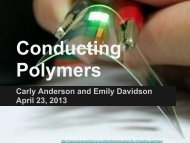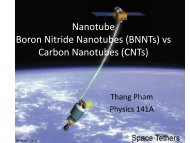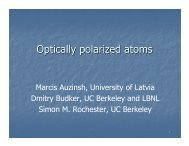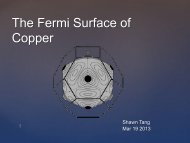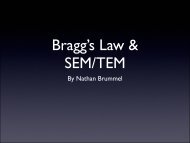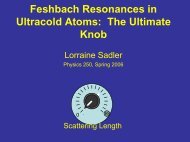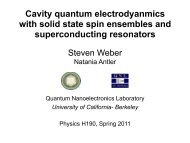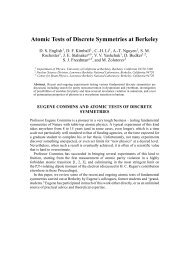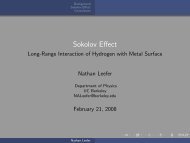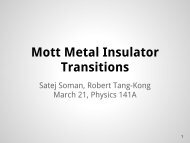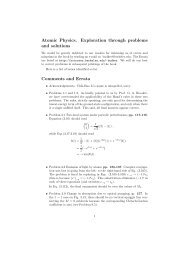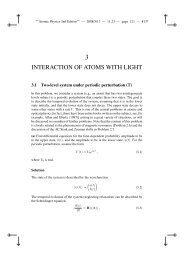Resonant nonlinear magneto-optical effects in atomsâ - The Budker ...
Resonant nonlinear magneto-optical effects in atomsâ - The Budker ...
Resonant nonlinear magneto-optical effects in atomsâ - The Budker ...
You also want an ePaper? Increase the reach of your titles
YUMPU automatically turns print PDFs into web optimized ePapers that Google loves.
35<br />
tically pump the atomic medium <strong>in</strong>to a polarized state<br />
which precessed with the Larmor frequency.<br />
D. Magnetic shield<strong>in</strong>g<br />
Nonl<strong>in</strong>ear <strong>magneto</strong>-<strong>optical</strong> <strong>effects</strong> are generally very<br />
sensitive to magnetic-field magnitude, direction, and gradients.<br />
For ground-state sp<strong>in</strong>-relaxation times of < ∼ 1 s,<br />
NMOE are maximum at sub-microgauss magnetic fields<br />
[Eq. (2)], necessitat<strong>in</strong>g their control at this level. 32 This<br />
control can be achieved with ferromagnetic shield<strong>in</strong>g <strong>in</strong><br />
spite of the fact that residual fields due to imperfections<br />
of the shield material are usually ∼10–50 µG (Kozlov<br />
et al., 1982). With a carefully designed four-layer magnetic<br />
shield and three-dimensional coil system <strong>in</strong>side the<br />
shield (see Fig. XI.A), it is possible to achieve long-term<br />
magnetic-field stability <strong>in</strong>side the <strong>in</strong>nermost shield at the<br />
level of 0.1 µG (<strong>Budker</strong> et al., 1998a; Yashchuk et al.,<br />
1999a, 2002a).<br />
Closed ferromagnetic shells shield different frequency<br />
external fields via different physical mechanisms. For<br />
static and very low-frequency external fields, the most<br />
important mechanism is flux shunt<strong>in</strong>g due to the high<br />
permeability of the material. At high frequencies, the<br />
sk<strong>in</strong> effect becomes the most important mechanism. A<br />
review of the early work on the shield<strong>in</strong>g problem, a theoretical<br />
treatment, and a survey of practical realizations<br />
was given by Sumner et al. (1987); see also books by<br />
Khriplovich and Lamoreaux (1997); Rikitake (1987).<br />
For static fields, the dependence of the shield<strong>in</strong>g ratio<br />
on the shape and size of n shield<strong>in</strong>g layers is given by an<br />
approximate formula:<br />
S tot ≡ B <strong>in</strong><br />
B 0<br />
n−1<br />
∏<br />
≃ S n<br />
i=1<br />
( ) ] k −1<br />
Xi+1<br />
S i<br />
[1 −<br />
, (32)<br />
X i<br />
where S i ≃ X i<br />
µ i t i<br />
.<br />
Here B 0 is the magnetic field applied to the shield, B <strong>in</strong><br />
is the field <strong>in</strong>side the shield, S i is the shield<strong>in</strong>g factor<br />
of the i-th layer, X i is the layer’s radius or length (depend<strong>in</strong>g<br />
on the relative orientation of the magnetic field<br />
and the layer), and t i and µ i are the thickness and magnetic<br />
permeability of each layer, respectively. We assume<br />
X i > X i+1 and µ i ≫ X i /t i . <strong>The</strong> power k depends on<br />
the geometry of the shield: k ≃ 3 for a spherical shield;<br />
k ≃ 2 for the transverse and k ≃ 1 for the axial shield<strong>in</strong>g<br />
factor of a cyl<strong>in</strong>drical shield with flat lids. Thus, for<br />
shields of comparable dimensions, spherical shells provide<br />
the best shield<strong>in</strong>g. In the design of the three outer<br />
32 <strong>The</strong>re are specific requirements to magnetic shield<strong>in</strong>g for the<br />
work with atoms <strong>in</strong> a cryogenic buffer gas environment discussed<br />
<strong>in</strong> Sec. VIII.D.2, <strong>in</strong> which relaxation times of up to m<strong>in</strong>utes are<br />
expected.<br />
layers of the four-layer shield shown <strong>in</strong> Fig. XI.A, an approximation<br />
to a spherical shape, simpler to manufacture<br />
than a true sphere, is used. <strong>The</strong> overall shield<strong>in</strong>g ratio<br />
is measured to be ∼10 −6 , roughly the same <strong>in</strong> all directions.<br />
<strong>The</strong> <strong>in</strong>nermost shield is <strong>in</strong> the shape of a cube with<br />
rounded edges. This allows compensation of the residual<br />
magnetic field and its gradients as well as application<br />
of relatively homogeneous fields with a simple system of<br />
nested 3-D coils of cubic shape (Yashchuk et al., 2002a).<br />
<strong>The</strong> field homogeneity is <strong>in</strong>creased by image currents, due<br />
to the boundary conditions at the <strong>in</strong>terface of the highpermeability<br />
material, which effectively make the short<br />
coils <strong>in</strong>to essentially <strong>in</strong>f<strong>in</strong>ite solenoidal w<strong>in</strong>d<strong>in</strong>gs.<br />
An important characteristic of a magnetic shield, <strong>in</strong><br />
addition to the shield<strong>in</strong>g factor and the residual fields<br />
and gradients with<strong>in</strong> the shielded volume, is the residual<br />
magnetic noise. One source of such noise is the Johnson<br />
thermal currents (Allred et al., 2002; Lamoreaux, 1999;<br />
Nenonen et al., 1996) <strong>in</strong> the shield itself.<br />
Superconduct<strong>in</strong>g shield<strong>in</strong>g (Cabrera, 1988; Cabrera<br />
and Halmilton, 1973, and references there<strong>in</strong>) yields the<br />
highest field stability. <strong>The</strong> shield<strong>in</strong>g properties of superconductors<br />
orig<strong>in</strong>ate <strong>in</strong> the Meissner effect, i.e., the exclusion,<br />
due to persistent currents, of magnetic flux from<br />
the bulk of a superconductor. Hamilton (1970); Taber<br />
et al. (1993) developed a technique for reduc<strong>in</strong>g the magnetic<br />
field <strong>in</strong>side a superconduct<strong>in</strong>g shield by expand<strong>in</strong>g<br />
the shield. When the dimensions of the superconduct<strong>in</strong>g<br />
enclosure <strong>in</strong>crease, the enclosed magnetic field decreases<br />
due to conservation of magnetic flux “frozen” <strong>in</strong>to the superconductor.<br />
In one experiment, expansion of a folded<br />
lead-foil (100 µm-thick) balloon was used; an ultra-low<br />
residual magnetic field (∼ 0.06 µG) was achieved over a<br />
liter-sized volume (Cabrera and Halmilton, 1973). With<br />
expanded lead bags as superconduct<strong>in</strong>g shields and a surround<strong>in</strong>g<br />
conventional ferromagnetic shield, a magnetic<br />
field of < 0.1 µG <strong>in</strong> the flight dewar of the Gravity Probe<br />
B Relativity Mission was ma<strong>in</strong>ta<strong>in</strong>ed <strong>in</strong> a 1.3 m-by-0.25<br />
m-diameter volume enclos<strong>in</strong>g a gyroscope (Mester et al.,<br />
2000), a shield<strong>in</strong>g ratio of about 5 × 10 −9 . Some limitations<br />
of superconduct<strong>in</strong>g shields were discussed by Dietzfelb<strong>in</strong>ger<br />
et al. (1990).<br />
An essential difference between superconduct<strong>in</strong>g and<br />
ferromagnetic shields is their opposite boundary conditions.<br />
S<strong>in</strong>ce a superconductor is an ideal diamagnetic<br />
material, magnetic field l<strong>in</strong>es cannot penetrate <strong>in</strong>to it,<br />
and so image currents are of opposite sign as those <strong>in</strong> ferromagnetic<br />
material. This is important for determ<strong>in</strong><strong>in</strong>g<br />
the shield geometry that provides the best field homogeneity.<br />
E. Laser-frequency stabilization us<strong>in</strong>g <strong>magneto</strong>-<strong>optical</strong><br />
<strong>effects</strong><br />
<strong>The</strong> development of frequency-stabilized diode laser<br />
systems has led to recent progress <strong>in</strong> experimental atomic<br />
and molecular physics <strong>in</strong> general, and the study of NMOE



